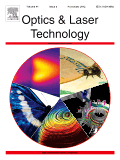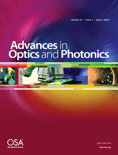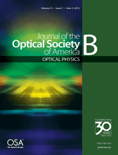
OPTICS AND LASER TECHNOLOGY
Scope & Guideline
Pioneering Insights in Laser Applications
Introduction
Aims and Scopes
- Laser Technology and Applications:
This area includes research on the development and application of laser systems across various industries, including manufacturing, medicine, and telecommunications. Studies often investigate novel laser sources, beam shaping techniques, and laser-material interactions. - Optoelectronics and Photonics:
Research in this scope focuses on the integration of optical devices for information processing and communication. Topics include optical sensors, photonic devices, and the development of novel materials for enhanced optical properties. - Nanostructured Materials and Applications:
This encompasses studies on the fabrication and application of nanostructured materials, utilizing laser techniques for enhanced properties in sensors, catalysts, and electronic devices. - Computational Methods in Optics:
This area includes the development and application of computational techniques for modeling and analyzing optical systems. Research often employs machine learning and advanced numerical methods to improve system design and performance. - Environmental and Biomedical Applications:
Research focusing on the use of optics and lasers in environmental monitoring, medical diagnostics, and therapeutic applications. This includes studies on sensors, imaging techniques, and therapeutic lasers. - Nonlinear Optics and Quantum Technologies:
This involves research into the nonlinear optical effects, such as frequency conversion and soliton dynamics, and their applications in quantum information processing and communication technologies.
Trending and Emerging
- AI and Machine Learning in Optics:
The integration of artificial intelligence and machine learning techniques in optical systems for data analysis, image processing, and system optimization is rapidly growing, showcasing the potential for enhanced performance and automation. - Advanced Laser Manufacturing Techniques:
Research focusing on innovative laser processing techniques, such as laser powder bed fusion and laser cladding, is on the rise as industries seek to enhance manufacturing capabilities and material properties. - Photonics for Sensing Applications:
The development of photonic sensors for environmental monitoring, healthcare diagnostics, and industrial applications is increasingly prominent, driven by the demand for precise and real-time data acquisition. - Quantum Photonics and Information Technology:
Research in quantum optics, including quantum communication and quantum computing applications, is emerging as a significant area of interest, reflecting the growing importance of quantum technologies. - Nonlinear Optical Devices and Applications:
Studies exploring nonlinear optical phenomena and their applications in developing new devices, such as frequency converters and ultrafast lasers, are gaining attention due to their potential for advanced technological applications.
Declining or Waning
- Basic Laser Physics:
Research focused solely on fundamental aspects of laser physics, such as basic laser operations and simple laser designs, has seen a decline as the field shifts towards more application-oriented studies and complex systems. - Traditional Optical Materials:
Studies concentrated on conventional optical materials without innovative modifications or applications are becoming less frequent as researchers explore advanced materials like metamaterials and nanocomposites. - Static Optical Systems:
The interest in static optical systems, such as fixed optical devices or lenses, is decreasing in favor of dynamic and tunable systems that can adapt to varying conditions and enhance functionality. - Basic Theoretical Models:
There appears to be a reduced emphasis on basic theoretical models without practical applications, as researchers increasingly focus on experimental validation and real-world applications of their findings.
Similar Journals

Chinese Optics Letters
Catalyzing collaboration in optical science.Chinese Optics Letters is a prestigious academic journal published by Chinese Laser Press, dedicated to advancing the fields of atomic and molecular physics, optics, as well as electrical and electronic engineering. Since its inception in 2003, this journal has become a significant platform for researchers and professionals to disseminate innovative findings and foster collaboration within these rapidly evolving disciplines. With a commendable Q2 ranking in leading categories including Atomic and Molecular Physics and Electronic, Optical and Magnetic Materials, it ranks favorably within the Scopus database, with notable positions in both engineering and materials science sectors. The journal is headquartered in Shanghai, China, and while additional open access options are not specified, it remains a vital resource for those committed to pushing the frontiers of optical research and applications. As we approach 2024, Chinese Optics Letters continues to play an essential role in shaping scholarly discourse and technological advancement in optics.

OPTICAL REVIEW
Innovating Insights in the World of LightOPTICAL REVIEW is a distinguished journal published by the Optical Society of Japan that serves as a critical platform for researchers, professionals, and students within the diverse fields of atomic and molecular physics and optics. With its ISSN 1340-6000 and E-ISSN 1349-9432, the journal has had a significant impact on the dissemination of knowledge since its inception in 1994, with a planned coverage until 2024. Although it currently holds a Q4 ranking in the 2023 category quartiles and is positioned at rank #152 out of 224 in the Scopus database, its contributions are vital for advancing optical science. This journal provides a venue for innovative research, review articles, and significant developments that drive the optical sciences forward. Although not categorized as Open Access, it remains an important resource for those seeking to deepen their knowledge and engage with leading-edge research in optics. With its base located at the Kudan-Kita Building in the heart of Tokyo, Germany, OPTICAL REVIEW is poised to continue fostering scholarly communication and collaboration on a global scale.

Advanced Optical Materials
Illuminating the Future of Materials ResearchAdvanced Optical Materials, published by WILEY-V C H VERLAG GMBH, stands as a premier journal within the fields of atomic and molecular physics, as well as electronic, optical, and magnetic materials. With a substantial impact factor reflecting its significance—ranking in the Q1 category among both Atomic and Molecular Physics and Electronic, Optical and Magnetic Materials—this journal offers a vital platform for disseminating groundbreaking research. The journal's Scopus rank positions it at an impressive 14th out of 224 in its category and 25th out of 284 in materials science, illustrating its commitment to advancing knowledge and innovation. Covering a diverse range of topics and trends from 2013 to 2024, Advanced Optical Materials is essential for researchers, professionals, and students who are exploring the cutting-edge developments in optical technologies. Despite not being open access, the journal provides high-quality peer-reviewed articles that contribute substantially to the academic community, helping to shape the future of materials research.

Advances in Optics and Photonics
Driving Innovation in Atomic and Molecular PhysicsAdvances in Optics and Photonics, published by the Optica Publishing Group, stands at the forefront of research dissemination in the fields of Atomic and Molecular Physics and Optics, alongside its prominence in Water Science and Technology. With an impressive Q1 ranking in both categories and a Scopus rank of #2/224, this journal boasts a 99th percentile status, underscoring its significance in the academic community. As a beacon of knowledge since its inception in 2009, the journal is dedicated to featuring cutting-edge research, innovative methodologies, and transformative applications in optics and photonics that can drive advancements across diverse scientific domains. While not an open-access journal, it provides vital insights for researchers, professionals, and students eager to stay updated on emerging trends and breakthroughs. With a convergence period extending to 2024, Advances in Optics and Photonics is positioned as an essential resource for anyone looking to explore the evolving landscape of light-based technologies.

Acta Photonica Sinica
Pioneering Insights in the Realm of OpticsActa Photonica Sinica is a peer-reviewed academic journal published by SCIENCE PRESS, focusing on the fields of atomic and molecular physics and optics. Since its inception in 1997, this journal has provided a crucial platform for researchers and professionals to share cutting-edge findings and advancements in photonics and related areas. Despite its current positioning in the Q4 quartile for both atomic and molecular physics and optics, Acta Photonica Sinica remains a significant contributor to the scholarly community, fostering innovative discussions and collaborations. The journal does not currently offer open access, providing a selective but impactful repository of knowledge for readers in China and beyond. As the scientific landscape evolves, the journal aims to enhance its scope and impact, addressing the challenges and opportunities within the photonics domain. Researchers, students, and professionals interested in the latest theoretical and experimental studies will find a wealth of information that emphasizes the pivotal role of optics in scientific and technological advancements.

Advanced Photonics Research
Illuminating the Future of PhotonicsAdvanced Photonics Research is a leading open-access journal published by WILEY, dedicated to advancing the field of photonics through rigorous research and comprehensive reviews. With its ISSN 2699-9293, the journal aims to disseminate innovative findings in areas such as photonic materials, devices, systems, and applications. Since transitioning to an Open Access model in 2020, it has significantly increased accessibility for researchers, professionals, and students alike, promoting wider dissemination and collaboration within the global photonics community. The journal's commitment to high-quality, peer-reviewed content ensures it remains an essential resource for those seeking to stay at the forefront of photonics research. Positioned to influence both academia and industry, Advanced Photonics Research is an invaluable platform for sharing cutting-edge discoveries that drive the future of technology.

Korean Journal of Optics and Photonics
Driving Discoveries in Optics and PhotonicsKorean Journal of Optics and Photonics is a premier publication dedicated to advancing knowledge in the rapidly evolving fields of optics and photonics. Published by the esteemed Optical Society of Korea, this journal serves as a vital platform for researchers, professionals, and students seeking to disseminate their findings and innovations in areas such as optical engineering, photonics technologies, and application developments. Although the journal does not operate under an Open Access model, it is committed to high-quality peer-reviewed research that contributes significantly to both theoretical and practical advancements in the field. With an increasing focus on interdisciplinary research, the Korean Journal of Optics and Photonics is poised to play a crucial role in fostering collaboration and driving the global conversation on light science and technology. The journal's ISSN is 1225-6285 and it also carries the E-ISSN 2287-321X, ensuring its availability to a wide readership.

Journal of Optics-India
Elevating Research Impact in the World of OpticsThe Journal of Optics-India, published by SPRINGER INDIA, serves as a vital platform dedicated to advancing research in the field of optics, focusing on topics in both atomic and molecular physics. With an ISSN of 0972-8821 and an E-ISSN of 0974-6900, the journal has been a consistent contributor to the field since its inception in 1996 and continues to thrive with its anticipated convergence through 2024. Although currently classified in Q3 of the 2023 category quartiles, the journal actively seeks to elevate its standing within Scopus rankings in physics and astronomy, where it holds a rank of 143/224, indicating significant opportunities for growth and research impact. The Journal of Optics-India is committed to fostering innovative research and providing scholars and practitioners with access to cutting-edge findings, thereby enhancing global conversations around optics and its vast applications. As a reliable source for researchers, professionals, and students alike, the journal emphasizes quality contributions that shape the future of optical science.

JOURNAL OF THE OPTICAL SOCIETY OF AMERICA B-OPTICAL PHYSICS
Unveiling the Wonders of Optical TechnologiesJOURNAL OF THE OPTICAL SOCIETY OF AMERICA B-OPTICAL PHYSICS, published by Optica Publishing Group, serves as a leading platform for groundbreaking research in the fields of optical physics, atomic and molecular physics, and statistical and nonlinear physics. With an ISSN of 0740-3224 and an E-ISSN of 1520-8540, this esteemed journal has been in circulation since 1984 and is dedicated to advancing the understanding of optical phenomena and related technologies. It holds a commendable position in the academic community, with a 2023 Scopus ranking reflecting its significance—placing it in the top quartile for both Atomic and Molecular Physics and Statistical and Nonlinear Physics. Although it is not an open-access publication, it provides extensive access options to ensure that research is disseminated effectively within the scientific community. This journal is instrumental for researchers, professionals, and students alike, aiming to keep them informed of the latest advancements and trends in optical science. With a convergence of expertise and innovation, JOSA B continues to play a pivotal role in shaping the future of optical research.

LASER PHYSICS
Transforming Ideas into Laser InnovationsLASER PHYSICS is a premier academic journal published by IOP Publishing Ltd, dedicated to the exploration and advancement of fundamental and applied research in the fields of Atomic and Molecular Physics, Optics, Condensed Matter Physics, Industrial and Manufacturing Engineering, and Instrumentation. Since its inception in 1996, the journal has been a vital resource for researchers and professionals, contributing significantly to the collective understanding of laser technology and its applications. With a consistent Q3 ranking across several sub-disciplines in the 2023 categories, LASER PHYSICS is recognized for its rigorous peer-reviewed articles that push the boundaries of current knowledge. Although primarily subscription-based, the journal aims to disseminate high-quality research to enhance the scientific community's collaboration. As the journal continues to shape the future of laser science until 2024 and beyond, it stands as an essential platform for both emerging and established scholars seeking to publish innovative findings in this dynamic field.